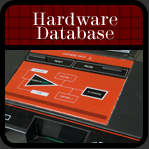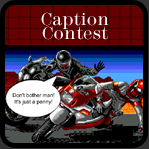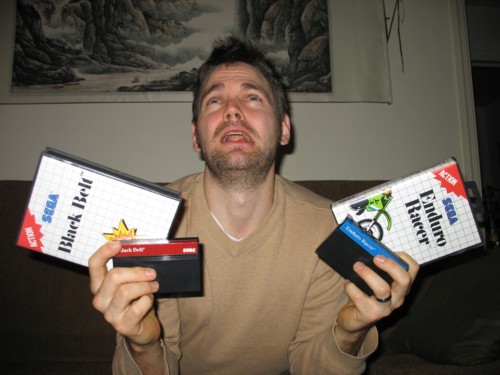 |
||
|---|---|---|
| Still clueless? |
Blue, red, red, blue, what? I'm sure you're confused now, but maybe not so confused, because most hardcore Master System collectors are aware of the red Alex Kidd in Miracle World rerelease as well as the red Fantasy Zone rerelease. First, let's get these guys out of the way. Now don't get all in a tizzy, there were only five of the red rereleases in total. They were, in alphabetical order, Alex Kidd in Miracle World, Black Belt, Choplifter, Fantasy Zone and Phantasy Star. Since you know what they look like now, based on packaging, there's no need to show the others. I should comment though that the Phantasy Star rerelease is only distinguishable from the addition of "With Battery Back-Up Memory" at the upper right, as well as the typical differences on the back. Other than this, simply look for the features I mentioned on the first page, and you're good to go. Oh yeah, one more thing, if you're worried about missing the manual and are wondering if they were rereleased too, the answer is yes. Every manual, except for one game that I'll get to, was redone on a more plain type of paper instead of the glossy paper used earlier in the Master System's life. The difference is not clearly evident from the pictures below (though you may notice something different about the way the light hits the rerelease manual on the left), but there's one sure way to know and here it is:
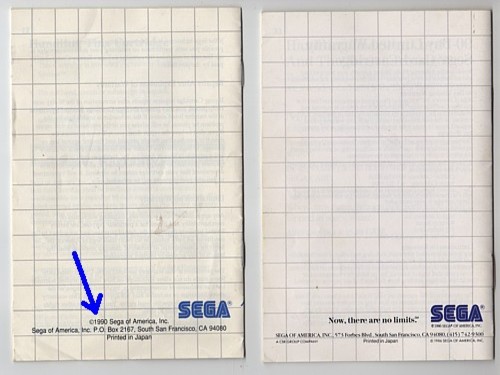 | ||
|
KABLAMO, no need to fear a missing manual again!
|
As you can clearly see, aside from paper type, which you may not be able to pick out in a lot or even a basic auction, the big giveaway here is the date. On all rerelease manuals the date will always be 1990 and nothing else. If you're in doubt, just ask whoever you may be purchasing a rerelease or manual from what the date is on the bottom of the back cover and you can't go wrong. Now, aside from your arsenal of information for completing this incredibly scare set, which I will list in full later, why were some of them red? The answer is simple. Sega, while attempting to use Tonka's marketing scheme of repackging the games, stuck with the original design of the labels for the cartridges. The system itself had a red square with of the same tint right under the cartridge slot so they were just sticking with tradition, but, and here's the point, right around 1990 Sega was releasing the Master System II in the United States.
They started to rerelease titles slightly before this, and then, with the arrival of the new system, decided to change the labels themselves to obviously match the color of the Sega logo in an effort to redesign nearly everything possible while doing everything in their power to give the system a little life extension on the market while at the same time testing the idea of genre marking the games to see if they'd sell better. Thus, the first five titles to be rereleased were in red, but the rest were rereleased in blue, which also coincides with the release of the only two blue titles not released in any other form, Alex Kidd in Shinobi World and Slap Shot.
As you can see, and to quote John, Sega's shift away from the SMS was "scattered because the majority of their efforts were focused on getting Sonic and Altered Beast ready to go." Further compounding what you've learned above is the presence of the blue rereleases, which began during the same year the SMSII was released. They were, in alphabetical order, California Games, Double Dragon, Enduro Racer, Fantasy Zone, Ghostbusters, Out Run, Rambo First Blood Part II and Reggie Jackson Baseball. There is further confusion to be added to the mix, because, as you realize now, Fantasy Zone was also rereleased in red. Let me get that out of the way first because it's simple. As I said above, Sega first rereleased the games in red, and then blue. Fantasy Zone was actually slated to be discontinued from the market, but Sega was so fond of Opa-Opa that it was continued. It was first rereleased in red with the others to test the new design and then was rereleased in blue when blue rereleases were being produced and the red rereleased Fantasy Zones were becoming sold out. This is why it tends to be one of the easiest rereleases to find, there were a number of them made. Note, though, that the blue is the more difficult to find of the two. The likely question many of you may have now is why did Sega pick some games over others? Why wasn't Great Baseball, for example, rereleased?
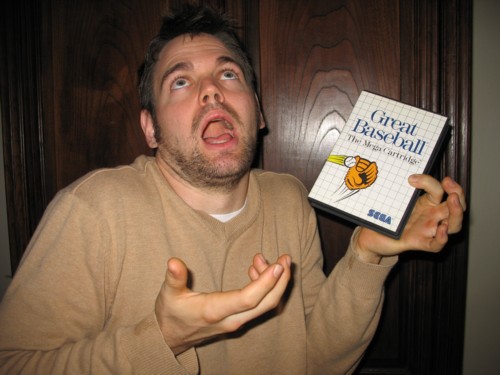 | ||
|
Hmmm, why wasn't such a great great rereleased?
|
The answer to this, as well, is simple, let me show you with the picture above. Well, not really, I just wanted to be a prick. The reason is something totally obvious you may have not have even thought about yourself. It happened to occur to me and I spoke with Tonto and nebrazca78 about it, both of whom believed the theory true when we discussed our reasonsing behind it. Luckily, I was able to find out from John that Sega simply chose to rerelease those games that sold the best and had the most market potential, exactly as assumed. Alex Kidd in Miracle World was one of the games that put the SMS on the map and also sold well, so it was chosen to be rereleased. However, since it didn't sell as well the second time around due to games like Super Mario Bros. 2 being on the market, it was not rereleased in blue. Games like Rambo or Reggie Jackson Baseball, however, though they may have sold well, were primarily selected because of this marketing factor I mentioned.
Rambo is easily recognizable to most Americans, so using this image to sell a game would have still worked, in theory. So though Alex Kidd in Miracle World was a highly popular game, he had faded away slowly while characters like Rambo were still fresh. With Reggie Jackson, the name attached a famous player to a title, thereby making it more marketable than Great Baseball. Thus, there's your answer, games were selected to be rereleased based on market potential and previous sale power, that's all there is to it.
The first of the blue rereleases was California Games, which can cause problems for collectors because it was rereleased with differences in box insert and manual in some cases, but not in others. Here's a further confusing factor to throw in the mix so I'll be brief. California Games was the first of them, so Sega simply used old stock of the game, adding blue cartridges after dumping red ones (perhaps another mountain of cartridges somewhere), and then later made new inserts as titles sold. It was thus at the tail end of the regular red-label games (not just rereleases) and marked the beginning of the blue rereleases. But since only one year had passed after it was first released, they used up what they had left and then altered the packaging and manuals later. Keep in mind that the 'reused rerelease' version of California Games (as we'll call it), is much easier to find than the 'true rerelease.' The latter has only been seen once.
The rest of the blue rereleases were simply released after the reds, in the same year. John, unfortunately, couldn't remember an exact month, but it's enough for us to know that within the same year the red rereleases were replaced by blues. But, the previously rereleased titles were not produced in blue cartridge format simply because they had already made a number and it wouldn't have been cost effective to do it all over again. Fantasy Zone is the only exception to this rule, simply because they sold so well in red that they had to make more and the blue rereleases were already being produced.
After hitting the market the blues were produced for only a year, and as already mentioned are easy to pick out simply based on appearance, aside from three problems. I've already covered the first with California Games and the second of the three problem games is Double Dragon. Unfortunately for us collectors interested in them, there is no way to tell outright which is a rerelease and which is a regular release, except for one, tiny detail. On ALL rereleases of both California Games and Double Dragon the "Sega" logo will be missing the registered trademark symbol (the R in a circle). This is true for the side logo as well. It's very hard to see depending on how far the picture is taken from the game, but if you get a glimpse of it or ask a sneaky question, you're good to go.
The back of their inserts is a slightly different story and the only other method you can use to pick the game out of a lot based on cover alone. On the back near the bottom there will be no mention of Tonka in the copyright information. Unfortunately, that's all you have because even the pictures are the same on the original title and organized like the rereleases. Ask the seller if it says "Tonka" below the Sega logo on the back, and you'll be fine, it's easy to spot otherwise using what you now know. Reggie Jackson Baseball also has this problem, but can be picked out in the same way you would Double Dragon. It should also be stated that Ghostbusters may present a minor problem to collectors because the rerelease looks like the PAL release from the front, but based on the back it becomes obvious it's a different game entirely. If you want to stay sneaky, ask the seller what the manual date is and you've got it.
So that's all you need to know about the legendary blues (and reds) from the NTSC market. The end of their history is the end of the Master System in the United States and I might as well give it to you to throw everything together. After 1990, in 1991 to be specific, Sega released Sonic the Hedgehog worldwide and thus a new legend was born. In a last ditch effort to keep the SMS alive for any fans left in America, they added three imports to the library, two of which are actually quite good. Out of these, one is considered by some fans to be one of the three greatest games for the system, ever. This time, however, instead of wasting more money on a market clearly dominated by Nintendo, Sega decided to end the life of the blue rereleases and the Master System, throwing out these last three titles (Sonic the Hedgehog, Spider-Man and Strider) only in import form with different UPC stickers.
In addition, they attempted to use up as much old stock as possible by throwing the well-known "Sega for the 90s The New Generation" stickers on the cartridges and back of the box inserts on a number of titles. This was simply to save making new labels entirely since the stickers were obviously cheaper and also helped Sega phase out the SMS in the United States as the Genesis began to take control of the market in the country. If you've noticed, this has thus far only been found on games that already share the genre marking envisioned by Tonka, such as Wonder Boy III: The Dragon's Trap. Some people consider these legit variations, while others find the difference too minor to bother. Regardless, this concludes our little investigation finally puts the mystery behind the blue cartridges to rest and gives you all the ability to find them, collect them and become one with the confusing history of the Master System in the United States. Just to have something handy, here's a list of every rerelease, in alphabetical order, to keep you busy for the next few years.
Go to....THE LIST!



